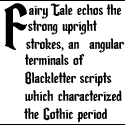October
From the 1200s through the early 1300s the civilized world was enjoying a rise in art, literature and education. Society was moving away from the chaos of the feudal structure, settling ever growing cities.This was a time of rapid expansion for the written word. The ever growing demand for books for common people drove the development of paper, and the rise of a scribe class. Lettering and the early dawns of typography was expanding rapidly throughout society -- as scribes strived to keep up with demand.
 But you're probably asking yourself what's the Black Plague got to do with typography? Besides being a fitting topic for our October issue, the Black Plague is probably one of the most important events in the letterform.
But you're probably asking yourself what's the Black Plague got to do with typography? Besides being a fitting topic for our October issue, the Black Plague is probably one of the most important events in the letterform.
In 1347, the Bubonic Plague began to spread across Europe. For more than thirty years it killed without warning -- sending more than forty percent of the population to the infernos of the funeral pyres. It became known as the "Black" plague because within four days of contracting the disease, the victim would die and the corpse would quickly turn black. Most unsavory.
The art of that period took a decided turn toward the dark. Superstition and beliefs in the evil supernatural raged like the fires of the burning dead. This was reflected in nearly all of the illustrations and woodblock prints of the late Gothic period. The dark condition of mankind's spirit echoed the rigid stems, pointed terminals and overall blackness of the scribe's "Textura" lettering -- called "Black Letter" which today is sometimes mislabeled "Old English."
It is no surprise therefore that the art and motif of "Halloween" quite often reflects the dark styles of the mid-1300s. Images like the shrouded grim reaper, the scythe, and skeletons all have their origins in the art of the Black Plague.
![]()
There is an upside to this story however. Although the plague nearly snuffed out civilization -- taking more than twenty-five million people -- some selective natural condition rendered many people immune to the plague. Those who survived the plague became obsessed with celebrating the end of the plague. One of the ways they celebrated was through art, literature and a refreshed interest in education.
A new movement emerged called the "Humanist" movement which spread a philosophy based on the 'human'. And with this new movement came a new look to the lettering of the times.
The styles of the Carolingian Round hand, with rounded letters developed several hundred years earlier faded into extinction -- until the Humanistic movement. The Humanistic hand, or "Rotunda" style evolved into a more open, rounded form than the condensed, angular black letter. These were spreading from some of the centers of literary arts of the times in France and Italy. The rounder, more flowing hand was embraced by scribes in the art and educational centers because it was faster to write, and it echoed the Carolingian form from the ancient Roman manuscripts saved from the sacking of Europe at the end of the Charlemagne empire.
Let's back up a few hundred years and see why Celtic and Carolingian styles influenced all of Europe
(continues next page)
- Questions or comments on this article?
- SUBSCRIBE : to the Designers' CAFE email list



